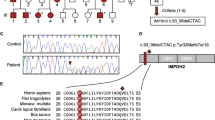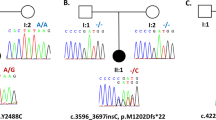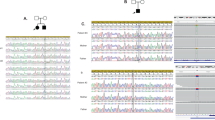Abstract
Hereditary progressive dystonia with marked diurnal fluctuation (HPD) (also known as dopa responsive dystonia) is a dystonia with onset in childhood that shows a marked response without any side effects to levodopa. Recently the gene for dopa responsive dystonia (DRD) was mapped to chromosome 14q. Here we report that GTP cyclohydrolase I is mapped to 14q22.1–q22.2. The identification of four independent mutations of the gene for GTP cyclohydrolase I in patients with HPD, as well as a marked decrease in the enzymes activity in mononuclear blood cells, confirms that the GTP cyclohydrolase I gene is a causative gene for HPD/DRD. This is the first report of a causative gene for the inherited dystonias.
This is a preview of subscription content, access via your institution
Access options
Subscribe to this journal
Receive 12 print issues and online access
$209.00 per year
only $17.42 per issue
Buy this article
- Purchase on Springer Link
- Instant access to full article PDF
Prices may be subject to local taxes which are calculated during checkout
Similar content being viewed by others
References
Segawa, M., Ohmi, K., Itoh, S., Aoyama, M. & Hayakawa, H. Childhood basal ganglia disease with remarkable response to L-Dopa, hereditary basal ganglia disease with marked diurnal fluctuation. Shinryo (Tokyo) 24, 667–672 (1971).
Segawa, M., Hosaka, A., Miyagawa, F., Nomura, Y., Imai, H. Hereditary progressive dystonia with marked diurnal fluctuation. Advances in Neurology vol 14 (eds Eldridge, R. & Fahn, S.) 215–233 (Raven Press, New York, 1976).
Nygaard, T.G., Marsden, C.D., Duvoisin, R.C. Dopa-responsive dystonia. Advances in Neurology vol 50 (eds Fahn, S., Marsden, C.D. & Calne, 0. B.) 377–384 (Raven Press, New York, 1988).
Nygaard, T.G., Snow, B.J., Fahn, S. & Calne, D.B. Dopa-responsive dystonia: Clinical characteristics and definition. Hereditary Progressive Dystonia with Marked Diurnal Fluctuation (ed. Segawa, M.) 21–35 (Parthenon, Camforth, UK, 1993).
Nomura, Y. & Segawa, M. Intrafamilial and interfamilial variations of symptoms of Japanese hereditary progressive dystonia with marked diurnal fluctuation. Hereditary Progressive Dystonia with Marked Diurnal Fluctuation (eds Segawa, M.) 73–96 (Parthenon, Camforth, UK, 1993).
Segawa, M., Nomura, Y. & Kase, M. Diurnally fluctuating hereditary progressive dystonia. Handbook of Clinical Neurology (eds Vinken, P.J., Bruyn, G.W. & Klawans, H.L.) 529–539 (Elsevier Science Publishers, New York, 1986).
Rajput, A.H. et al. Dopa-responsive dystonia: Pathological and biochemical observations in a case. Ann. Neurol. 35, 396–402 (1994).
Fletcher, N.A. et al. Tyrosine hydroxylase and levodopa responsive dystonia. J. Neurol. Neurosurg. Psychiatry 52, 112–114 (1989).
Tsuji, S. et al. Linkage analysis of hereditary progressive dystonia to the tyrosine hydroxylase gene locus. Hereditary Progressive Dystonia with Marked Diurnal Fluctuation (ed. Segawa, M.) 107–114 (Parthenon Publishing, New York, 1993).
Nygaard, T.G. et al. Linkage mapping of dopa-responsive dystonia (DRD) to chromosome 14q. Nature Genet. 5, 386–391 (1993).
Endo, K. et al. The gene for hereditary progressive dystonia with marked diurnal fluctuation (HPD) maps to chromosome 14q. Age-related monoamine-dependent disorders and their modulation by gene and gender (eds Segawa, M. & Nomura, Y.) (Karger, Basel, 1995, in the press).
Kaufman, S. Studies on the mechanism of the enzymatic conversion of phenylalanine to tyrosine. J. biol. Chem. 234, 2677–2682 (1959).
Nagatsu, T., Levitt, M. & Udenfriend, S. Tyrosine hydroxylase: the initial step in norepinephrine biosynthesis. J. biol. Chem. 239, 2910–2917 (1964).
Lovenberg, W., Jaquier, E. & Sjoerdsma, A. Tryptophan hydroxylation: measurement in pineal gland, brainstem, and carcinoid tumor. Science 155, 217–219 (1967).
Nichol, C.A., Smith, G.K. & Duch, D.S. Biosynthesis and metabolism of tetrahydrobiopterin and molybdopterin. Ann. rev. Biochem. 54, 729–764 (1985).
Togari, A., Ichinose, H., Matsumoto, S., Fujita, K. & Nagatsu, T. Multiple mRNA forms of human GTP cyclohydrolase I. Biochem. Biophys. res. Commun. 187, 359–365 (1992).
Nomura, T. et al. Cloning and sequencing of cDNA encoding mouse GTP cyclohydolase I. Biochem. Biophys. res. Commun. 191, 523–527 (1993).
Ichinose, H. et al. Cloning and sequencing of cDNA encoding human sepiapterin reductase — An enzyme involved in tetrahydrobiopterin biosynthesis: Biochem Biophys. res. Commun. 179, 183–189 (1991).
Levine, R.A., Miller, L.P. & Lovenberg, W. Tetrahydrobiopterin in striatum: localization in dopamine nerve terminals and role in catecholamine synthesis. Science 214, 919–921 (1981).
Kettler, R., Bartholini, G. & Pletscher, A. In vivo enhancement of tyrosine hydroxylation in rat striatum by tetrahydrobiopterin. Nature 249, 476–478 (1974).
Nagatsu, T. Biopterin cofactor and monoamine-synthesizing monooxygenases. Selected Topics in Neurochemistry (ed. Osborne, N.N.) 325–340 (Pergamon Press, Oxford, 1985).
Miwa, S., Watanabe, Y. & Hayaishi, O. 6R-L-erytnro-5,6,7,8-tetrahydrobiopterin as a regulator of dopamine and serotonin biosynthesis in the rat brain. Arch. Biochem. Biophys. 239, 234–241 (1985).
Williams, A., Eldridge, R., Levine, R., Lovenberg, W. & Paulson, G. Low CSF hydroxylase cofactor (tetrahydrobiopterin) levels in inherited dystonia. Lancet 2, 410–411 (1979).
LeWitt, P.A. et al. Tetrahydrobiopterin in dystonia: identification of abnormal metabolism and therapeutic trials. Neurology 36, 760–764 (1986).
Fink, J.K. et al. Dystonia with marked diurnal variation associated with biopterin deficiency. Neurology 38, 707–711 (1988).
Furukawa, Y., Nishi, K., Kondo, T., Mizuno, Y. & Narabayashi, H. CSF biopterin levels and clinical features of patients with juvenile parkinsonism. Advances in Neurology vol 60 (eds Narabayashi, H., Nagatsu, T., Yanagisawa, N. & Mizuno, Y.) 562–567 (Raven Press, New York, 1993).
Blau, N., Joller, P., Atarés, M., Cardesa-Garcia, J. & Niederwieser, A. Increase of GTP cyclohydrolase I activity in mononuclear blood cells by stimulation: detection of heterozygotes of GTP cyclohydrolase I deficiency. Clin. Chim. Acta 148, 47–52 (1985).
Hatakeyama, K., Harada, T., Suzuki, S., Watanabe, Y. & Kagamiyama, H. Purification and characterization of rat liver GTP cyclohydrolase I—Cooperative binding of GTP to the enzyme. J. biol. Chem. 264, 21660–21664 (1989).
Nygaard, T.G., Marsden, C.D. & Fahn, S. Dopa-responsive dystonia: long-term treatment response and prognosis. Neurology 41, 174–181 (1991).
Takahashi, H. et al. Biochemical and fluorodopa positron emission tomographic findings in an asymptomatic carrier of the gene for dopa-responsive dystonia. Ann. Neurol. 35, 354–356 (1994).
Bernheimer, H., Birkmayer, W., Hornykiewicz, O., Jellinger, K. & Seitelberger, F. Brain dopamine and the syndromes of Parkinson and Huntington. Clinical, morphological and neurochemical correlations. J. neurol. Sci. 20, 415–455 (1973).
Niederwieser, A. et al. GTP cyclohydrolase I deficiency, a new enzyme defect causing hyperphenylalaninemia with neopterin, biopterin, dopamine, and serotonin deficiencies and muscular hypotonia. Eur. J. Pediatr. 141, 208–214 (1984).
Dhondt, J.-L. et al. Neonatal hyperphenylalaninemia presumably caused by guanosine triphosphate-cyclohydrolase deficiency. J. Pediatr. 106, 954–956 (1985).
Naylor, E.W. et al. Guanosine triphosphate cyclohydrolase I deficiency: early diagnosis by routine urine pteridine screening. Pediatrics 79, 374–378 (1987).
Reisert, I., Engele, J. & Pilgrim, Ch. Early sexual differentiation of diencephalic dopaminergic neurons of the rat in vitro. Cell tissue Res. 255, 411–417 (1989).
Kapatos, G. Tetrahydrobiopterin synthesis rate and turnover time in neuronal cultures from embryonic rat mesencephalon and hypothalamus. J. Neurochem. 55, 129–136 (1990).
Fink, J.K. et al. Tetrahydrobiopterin administration in biopterin-deficient progressive dystonia with diurnal variation. Neurology 39, 1393–1395 (1989).
Hoshiga, M., Hatakeyama, K., Watanabe, M., Shimada, M. & Kagamiyama, H. Autoradiographic distribution of [14C] tetrahydrobiopterin and its developmental change in mice. J. pharmacol. Exp. Ther. 267, 971–978 (1993).
Harada, T., Kagamiyama, H. & Hatakeyama, K. Feedback regulation mechanisms for the control of GTP cyclohydrolase I activity. Science 260, 1507–1510 (1993).
Takahashi, E., Hori, T., O'Connell, P., Leppert, M. & White, R. R-banding and nonisotopic in situ hybridization: precise localization of the human type II collagen gene (COL2A1). Hum. Genet. 86, 14–16 (1990).
Takahashi, E. et al. Chromosome mapping of the human cytidine-5′-triphosphate (CTPS) gene to band 1p34.1-p34.3 by fluorescence in situ hybridization. Hum. Genet. 88, 119–121 (1991).
Viegas-Péquignot, E., Lin, L.Z., Dutrillaux, B., Apiou, F. & Panliu, D. Assignment of human desmin gene to band 2p35 by nonradioactive in situ hybridization. Hum. Genet. 83, 33–36 (1989).
Takahashi, E., Hori, T., O'Connell, P., Leppert, M. & White, R. Mapping of the MYC gene to band 8q24.12-q24.13 by R-banding and distal to fra (8) (q24.11), FRA8E, by fluorescence in situ hybridization. Cytogenet. cell Genet. 57, 109–111 (1991).
Sawada, M. et al. A sensitive assay of GTP cyclohydrolase I activity in rat and human tissues using radioimmunoassay of neopterin. Anal. Biochem. 154, 361–366 (1986).
Higuchi, R., Krummel, B. & Saiki, R.K. A general method of in vitro preparation and specific mutagenesis of DNA fragments: study of protein and DNA interactions. Nucl. Acids Res. 16, 7351–7367 (1988).
Ho, S.N., Hunt, H.D., Horton, R.M., Pullen, J.K. & Pease, L.R. Site-directed mutagenesis by overlap extension using the polymerase chain reaction. Gene 77, 51–59 (1989).
Bradford, M.M. A rapid and sensitive method for the quantitation of microgram quantities of protein utilizing the principle of protein-dye binding. Anal. Biochem. 72, 248–254 (1976).
Hatakeyama, K., Inoue, Y., Harada, T. & Kagamiyama, H. Cloning and sequencing of cDNA encoding rat GTP cyclohydrolase I—The first enzyme of the tetrahydrobiopterin biosynthetic pathway. J. biol. Chem. 266, 765–769 (1991).
Author information
Authors and Affiliations
Rights and permissions
About this article
Cite this article
Ichinose, H., Ohye, T., Takahashi, Ei. et al. Hereditary progressive dystonia with marked diurnal fluctuation caused by mutations in the GTP cyclohydrolase I gene. Nat Genet 8, 236–242 (1994). https://doi.org/10.1038/ng1194-236
Received:
Accepted:
Issue Date:
DOI: https://doi.org/10.1038/ng1194-236
This article is cited by
-
Allelic phenotype prediction of phenylketonuria based on the machine learning method
Human Genomics (2023)
-
Catecholamines and Parkinson’s disease: tyrosine hydroxylase (TH) over tetrahydrobiopterin (BH4) and GTP cyclohydrolase I (GCH1) to cytokines, neuromelanin, and gene therapy: a historical overview
Journal of Neural Transmission (2023)
-
Rare variants in IMPDH2 cause autosomal dominant dystonia in Chinese population
Journal of Neurology (2023)
-
Mutation screening of AOPEP variants in a large dystonia cohort
Journal of Neurology (2023)
-
Epigenetic inactivation of the autophagy–lysosomal system in appendix in Parkinson’s disease
Nature Communications (2021)



